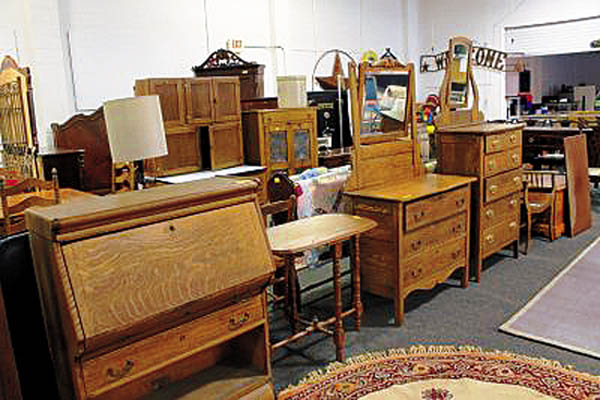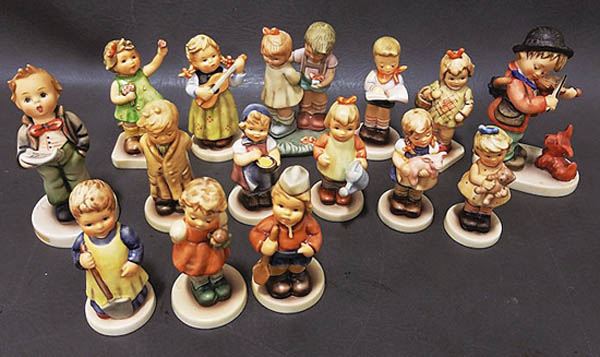Whats Happened To The (Fill-In-The-Blank) Category?
An Examination Of Today’s Market
By Mike Ivankovich - February 07, 2020
I love antiques and collectibles and have for north of 40 years. However, neither my children, nor their friends, collect anything today. And Im not alone. I hear it nearly every day, especially when I teach my Your Children Dont Want It. What Can You Do? program, where most attendees report the same sentiment. Whats happened? Where did we go wrong? Well, actually, its just a generational and evolutionary thing. But whether you collected milk glass, Hummel or other figurines, cut glass or crystal, depression or carnival glass, ironstone, Currier & Ives lithographs, brown furniture, or (fill-in-the-blank), the cycle for so many different collecting categories has been remarkably similar. For me and many others, its been a near lifetime ride. I didnt understand what was happening at the time. But now as I look back, Ive seen a similar cycle, regardless of the collecting category. So, heres my analysis of Whats Happened to the (Fill-in-the-Blank) Market. *The 1960s-1970s began the rise of mainstream collecting. Prices were low, and collectors were able to furnish their homes relatively inexpensively, while at the same time assembling impressive collections. *At that time relatively few reference books and price guides were available. Collectors had to figure out what was common vs. rare or what was good-better-best mostly on their own. *Trade papers, supported by the advertising dollars of classified ads, antique shops and malls, antiques shows, and auctioneers began to emerge. And they promoted nearly all areas of collectibles, which fueled collector interest. Collecting became mainstream and cool. *Collector Clubs were organized as a way for collectors to buy, sell, trade, and learn about their fill-in-the-blank category of collectible. *With an increasing number of collectors entering the marketplace, prices began to rise, with more people chasing after a finite amount of merchandise. *As prices began to rise, many collectors became dealers in order to finance their collecting habits. *Specialty dealers, specialty shops, specialty shows, and specialty auctions began to emerge to cater to various collector demands. *Over the years, price guides, reference books, and trade publications began to proliferate, which enabled collectors to better understand desirability, scarcity, and marketplace value. *As collectors began to understand common vs. rare and condition, condition, condition, for better or worse, the mantra became buy the best you can afford. Rarities began to command premium prices because (we assumed) there would always be a buyer for the best-of-the-best. *Somewhere along the way, as prices increased, collectibles became investibles, and collectors began to view their collection as an asset class. Who didnt have an Excel spreadsheet or hand-written tally detailing the size and value of their collection? *As antiques and collectibles continued to increase in value, the perception grew that the older it gets, the more valuable it will be. There was a belief that value would never decrease and that there would always be another buyer who valued fill-in-the-blank the way we did. Few people admitted losing money on a purchase. *Increasing prices were further fueled by income growth and rising real estate values. For many, the older we aged, the more disposable income we had in our pockets to invest in fill-in-the-blank. Many took out home equity loans, and much of that money was invested in further antiques and collectibles speculation. *Some even began to view their personal collections as a possible retirement vehicle, with plans of one day opening their own antique shop or joining the antique show circuit, specializing in fill-in-the-blank. *From the 1980s to early 2000s, as prices were rising, new collectors continued to enter the market, which for the time being made up for those collectors who were leaving the market due to age, death, or changing lifestyles. *For me, Sept. 11, 2001, was the symbolic date of change. America got hit in the gut, and all of a sudden, antiques and collectibles just didnt seem as important as before. Collecting demand seemed to lose some steam. *As we advanced into the 21st century, there just werent enough new collectors replacing the older ones who were leaving the marketplace. Fewer people with disposable income chasing after a finite amount of merchandise inevitably led to a softening in prices (softening is dealer jargon for prices are dropping like a rock in water). *A deteriorating economy, $5.00 per gallon gas prices, and the growth of eBay and digital era all further detracted from the thrill of the hunt, which contributed to the shrinking demand for fill-in-the-blank. *And with the changing of the guard, younger people who are established enough to have disposable income preferred to spend their money differently than their parents. Electronics, travel, life experiences, and minimalist living meant more to them than outdated tangible items that collected dust. Where their parents saw opportunity in the fields of antiques and collectibles, much of the younger generation didnt share the appeal. *As older collectors downsized and passed away, their children just didnt care about the fill-in-the-blank pieces the way their parents did. They may have wanted to keep one or two items to remember them by, but the majority of the collection was ultimately sold and re-entered the marketplace. *And over the years, with an increasing amount of merchandise re-entering the marketplace, and too few buyers to absorb it all, prices in the fill-in-the-blank category began to decline. And often quite drastically. *With fewer buyers today, many antiques shops have closed. Many antiques shows have disappeared. Many collector clubs have disbanded. And many trade publications have closed their doors. All because of the decline in collector interest. *All categories did not decline at the same rate or at the same time. It all depended upon who was left in the fill-in-the-blank category. Harry Rinker once wrote that every collectible category was dominated by only 15-20 serious collectors and dealers who kept that market strong. Once those market influencers left, if not replaced by other equally motivated collectors and dealers, the category would collapse. I think he was right. And this is exactly what has been happening over the past ten years. Some categories have remained strong because there are still enough serious and motivated buyers to sustain the market (e.g., high-end antique toys or decoys). But what will happen to these high-end prices when those remaining market influencers leave that market? It seems pretty predictable to me. *If you have assembled a collection as an investment, youre probably already disappointed. If you assembled your collection because you love what you collect and live with, you collected for the right reason and can still enjoy your collection without worrying about the financial consequences. *Collecting has been extremely fun. Over the past 40 years, my wife and I have traveled extensively, experienced the thrill of the hunt, bought and sold, attended conventions, ran auctions, set up at shows, worked the internet, furnished our home, published books and articles, and made many lifetime friendships. We still buy and still add to our collection(s), we just dont pay as much as we used to. We continue to enjoy what weve collected and remember stories about where we found most things and got the best deals. We miss the old days but have been able to accept it as it is, what it is. *The 2008-09 recession was a serious one that changed the landscape, so did the digital era, and all have ramifications. And the good news, its a buyers market, and there are great deals to be had out there. Take advantage of it. Support your regional shops, auction houses, and trade papers. Mike Ivankovich is an auctioneer, appraiser, home downsizing expert, and host of the Whats It Worth? Ask Mike the Appraiser radio show. Now in its sixth year, Whats It Worth airs live in the Philadelphia area on Friday mornings from 9:30-10:30 a.m. EST on WBCB 1490 AM, and on the internet at www.WBCB1490.com. You can also visit his Radio Show Web Site at www.AskMikeTheAppraiser.com If your local station doesnt carry Whats It Worth, tell them they need to add it to their programing mix. To contact Mike, call 215-264-4304 or visit www.michaelivankovichappraisals.com.





SHARE
PRINT